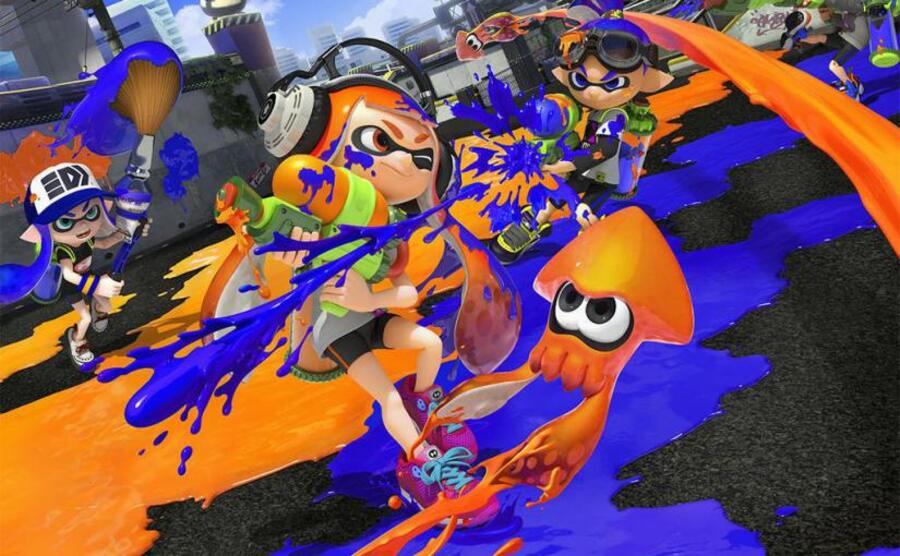
Though the claims that Nintendo simply doesn't tackle new ideas aren't entirely fair, there's little denying that Splatoon has been a breath of fresh air on Wii U. As a new IP that utilises a genre so rarely entertained by Nintendo - a third-person shooter - it appears to have succeeded in grabbing attention and exciting established and new fans. The buzz in Nintendo communities can't be ignored, it's been critically acclaimed and early chart results for the UK and Japan show strong sales.
Splatoon is everywhere, then, and that's a major benefit for the Wii U in its hunt for evergreen titles that will, at the very least, keep it ticking over and maintain support from current owners. Its timing and impact, so far, will have surely given Nintendo confidence, and perhaps we can add Inklings to the list of Nintendo characters we'll happily see more of in years to come.
That's looking ahead a little too far, and as we're just days into release we have plenty of time to delve into the detail of this Wii U title. With that in mind we were fortunate enough to pose some questions to Splatoon producer Hisashi Nogami. Nogami-san has an intriguing history with Nintendo, with his lengthy CV including a prominent role in the creation of Mii characters, which made their début on Wii and have become an essential part of the Nintendo experience.
We asked Nogami-san about the design approaches behind Splatoon, its target audience and more.
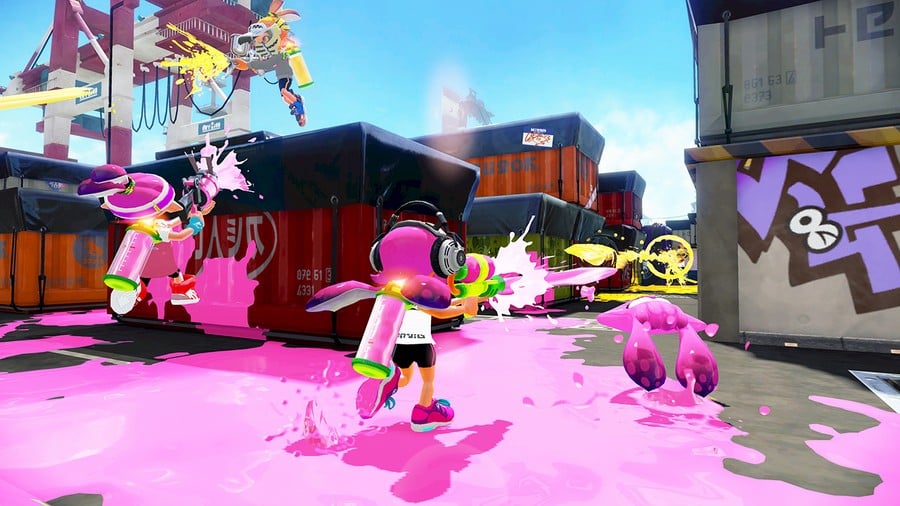
Though often described as a 'shooter', Splatoon offers its own distinct approach to the genre. Can we begin with your perspective on what makes this title stand out as unique from other shooters?
We didn't set out to create a game that simply improved on something already out there. We wanted to create something from scratch with an entirely new form of gameplay; something that we felt was truly fun.
The prototype for Splatoon was a demo made by our Program Director Shintaro Sato. Two teams of four players would shoot ink at each other to paint the ground and compete over turf. The game really works because of the following elements included in this demo: a third person view and overview map shown on the TV and Wii U GamePad; having your progress instantly reflected on the map as you spray ink around to edge yourself closer to victory, allowing other players to know what you were doing; not having your position revealed to the enemy team so long as you remain in your team's coloured areas.
While there were also shooter elements already there from the start, it was by adding in the kind of playability you find in Nintendo action games that turned the game into what it is now.
If Splatoon looks unique as a shooter, I'd say it's because we didn't set out to make a unique shooter in the first place.
It's been stated that existing Nintendo IPs were previously considered for Splatoon, before the concept for squids was decided upon. How important was that decision in terms of the final concept and the player abilities that define the gameplay?
One option we had was to use an existing IP, but our biggest focus was on a character design that best communicated the gameplay. As our objective here was to create something with gameplay the likes of which hadn't been seen before, we felt new characters would be best to represent this as opposed to an existing IP, hence why we went in that direction.
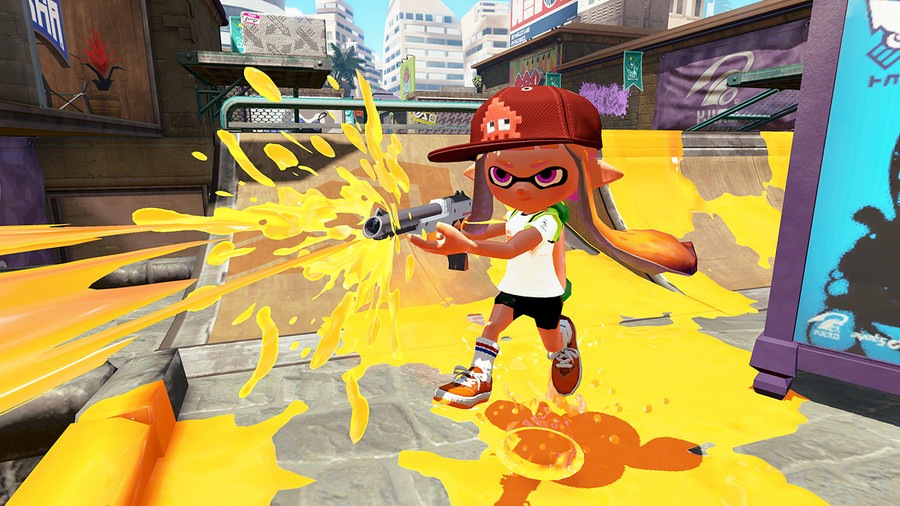
The strategies to win in Splatoon are unique from standard shooters - do you think players will take time to learn and refine strategy, in terms of covering territory as opposed to primarily targeting opponents?
'Gain more turf than the opposing team' is an immediately understandable goal, and figuring out what you need to do to achieve this comes quickly once you start playing.
All you need to do is cover the ground in ink, and avoid interference by your opponents.
I think more complex strategies will emerge as users play over and over again and invest some time in the game.
Considering the unconventional moves of the squid and the inking mechanics, what were the biggest challenges in finding the right balancing with weapons and abilities?
Providing a rapid, three-dimensional moveset for the squid, while also enabling players to accurately aim at opponents was something we were only able to achieve thanks to the Motion Controls.
This control style is often mistaken as being similar to that used in Wii U Panorama View, but it's actually very different. Tilting the Wii U GamePad just a little moves the camera (field of view) a lot. If I were to make an analogy, it's like your wrists become a third analogue stick; they're perfectly suited for smoothly and fluidly changing the direction you are facing.
This control scheme allows for rapid and intuitive execution of complex moves; it's a cinch to make a lane by painting a wall in ink, swim up it as a squid, and aim at an opponent from high up before splatting them.
Players already familiar with controlling cameras using sticks can also use this style instead.
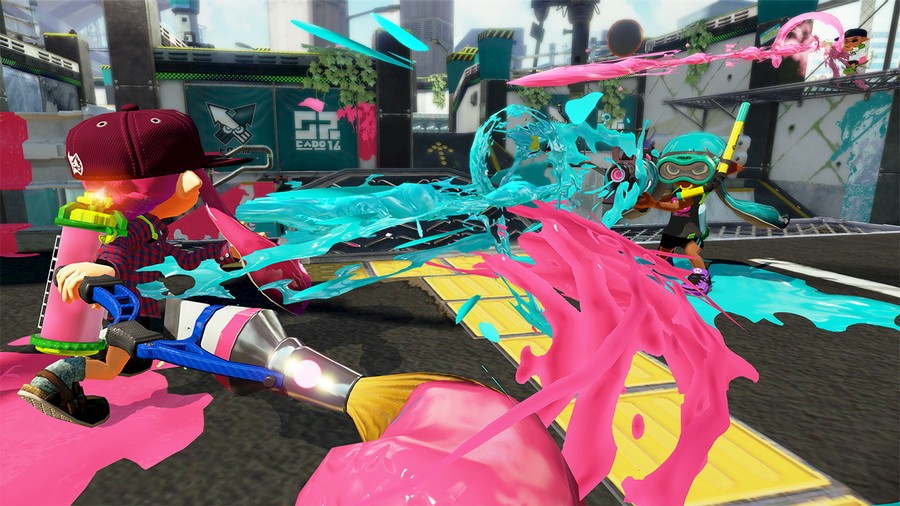
How important is the single player campaign in enhancing the overall experience, and do you think it's vital for players to complete it?
Completing the single-player campaign isn't a must, and users can just play however they want, even if it's just the online multiplayer and Battle Dojo sections.
However, we're confident that the single-player mode has something to offer too. Players not confident with the controls for the squid can hone their skills here, while users who are already familiar with them from online multiplayer will find this mode still has a lot to offer them too. We hope you don't skip it! There's also a small reward waiting for you once you complete it!
Can you explain the reasoning for gradually rolling out additional stages, items and modes in the months after release?
There are two reasons for this:
First, we put a lot of effort into every inch of the online stages, so by playing them over and over again users can get a better feel for the terrain, giving the gameplay more breadth and depth. The characteristics of the weapons and the strategies for using them vary with each weapon, and of course these will vary depending on the stage you use them in and even what combination of equipment your teammates and opponents are using. We want users to enjoy each and every single piece of content we've prepared, so rather than provide a lot at once, we're going to be adding them a little at a time.
Second, is that while we've paid a lot of attention to the balancing the game, the flip-side of this is that we feel the game needs weapons with a lot of variety as well as stages with complex layouts to really expand the gameplay.
The problem there is that these can sometimes disrupt the overall balance of the game.
The real fun of Splatoon comes when players are comfortable with the game, and are able to play to their full potential with other players they meet in the online matches.
We'll be adding more stages and weapons as we see how the community matures. We'll also do something similar with further game modes too.
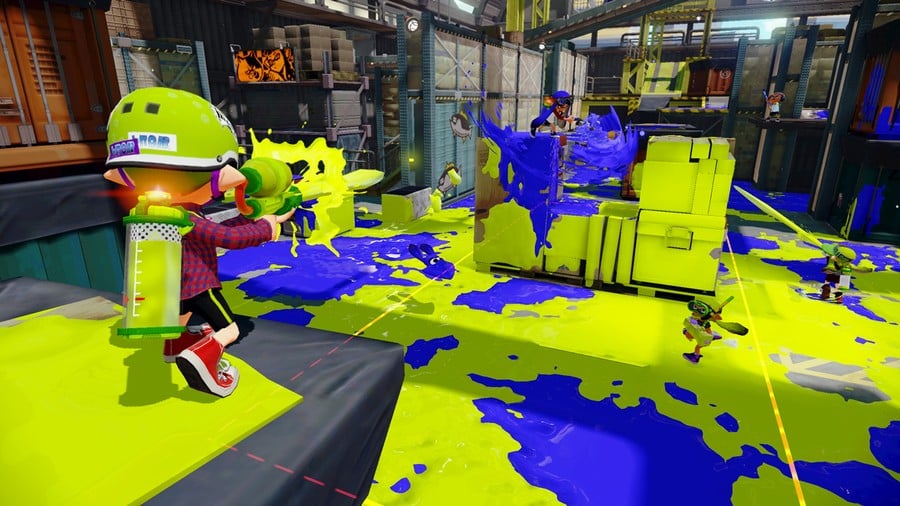
The absence of voice chat, as a design choice, has been a notable topic - what's your perspective on the demands from some gamers for some chat functionality, even if it's limited to those on a system's Friends List?
As I mentioned, we didn't set out to create a game that simply improved on something already out there, but to create something entirely new. We want everyone to play this game from the same point, so that all players – those who haven't played shooters before, as well as those who have – can enjoy the game. Getting to this though meant going through a selection process for all features that should appear in the game, and as part of this process we decided to leave out voice chat.
We think there are two reasons for wanting to use it: to play strategically, and to know what you opponent is feeling. We designed the game so that it's still possible to play strategically, while also giving due consideration so that there is no extreme advantage one way or the other. In terms of knowing what your opponent is feeling, we really do understand the fun that can be had with this, but we hope that you will also understand that it can also have a negative effect too.
What was your reaction when told Splatoon would have its own amiibo range, and what were your priorities when developing the content linked to the figurines?
The Splatoon characters – the Inklings – were designed based on their abilities, but we're also fairly confident that we managed to make them visually appealing too. When we learned they would be made into amiibo, our first thought was that it would give users already interested in the game one more reason to like it.
We also wanted to get our hands on them before anyone else too!
We prioritized having the characters appear in game exactly as they do on the figurine. After that, we decided on what they should do for the player by looking at the other elements that already make up the structure of the game.
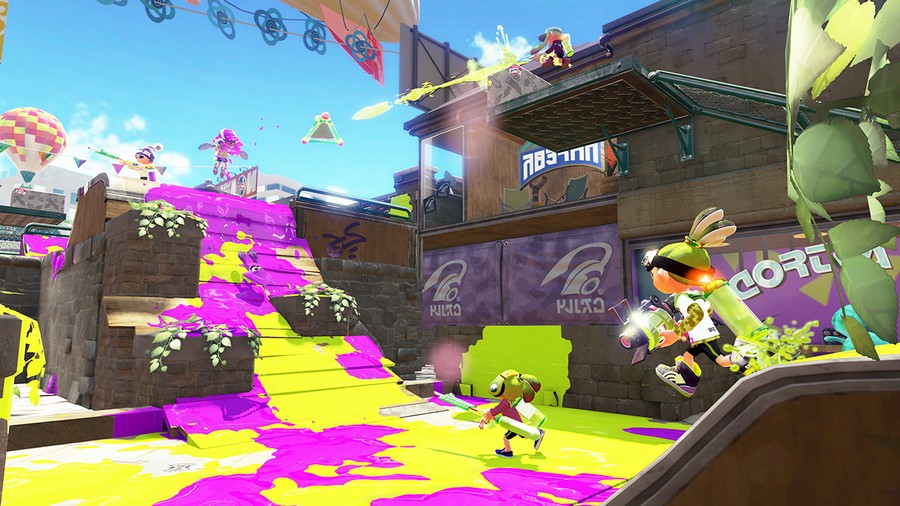
With its colourful graphics and style Splatoon can no doubt appeal to young gamers, but are you confident that players of all ages will be excited about the game?
As children, we all dreamed of being able to coat a town in ink (although of course we were never allowed), so being able to do this in a game is something we feel a lot of people are going to be interested in, regardless of age or gender.
We've also filled the game with things we loved when we were teenagers, including fashion and music and hope that users who can relate to this will find the graphics and audio of the game appealing too.
Having said that though, to really 100% understand what we're talking about you need to see and experience it for yourself as opposed to just imagining it in your head.
We hope that the parents of younger gamers, watching the screen from behind will feel compelled to jump in and play Splatoon too.
We'd like to thank Hisashi Nogami for his time. Be sure to check out our Splatoon review for our assessment of Nintendo's shooter.





Comments 46
Speaking and chatting with friends a negative? But people can call me on WiiU chat anytime but i can't speak in game with friends what even is this crap.
As much as I love Splatoon, do we really need a billion articles about it?
Good interview. Very much enjoying the game and I'm very happy to see all the positive online, and the good sales (minus the comment section here so far anyway).
Very sneaky NintendoLife. Creating two articles and recycling content lol
https://www.nintendolife.com/news/2015/06/splatoon_producer_inks_out_reasons_for_lack_of_voice_chat_and_staggered_content_roll-out
@Ichiban at least it's not another Xenogears story.
The game is a lot of fun. Sure, there are features we wish were there, but let us not forget just how original and enjoyable the gameplay actually is!
Sick of the outdated views on voice chat that they have but I know I'll get a lot of hate for expressing my opinion about that like always. I just feel like the people against voice chat have never used it before or never used it properly. Good interview and great game that just needs some online-mechanics polished.
I understand why some people want voice chat but I've personally never really seen the appeal of it in practice to be honest. Even in a game like Counter Strike (1.5–Source era) I'd just turn everyone's voices off. I could do without douche-bags shouting in my ear or playing random sounds over and over and over and over, just to annoy people. I also never really felt this desire to co-ordinate with others to be honest. I just generally watched what they were up to, checked the map every now and then (occasionally using that to coordinate with them to a degree), and basically did my own thing for the most part. Still; I get why some people want it and I think it would be nice to at least have the option for friends to use it among themselves—and proper teams if they every set that kind of thing up.
I 100% agree with no voicechat in Splatoon. It would make recon very overpowered and I know many would abuse it to give away the location of all opponent to their team. Perhaps Nintendo will have to remove it anyway once friends are teaming up and using Skype on the side. I like the option for voicechat in games, but Splatoon was designed without it and adding it will break the design.
@DarthNocturnal Japan can be really weird sometimes. It's one of the reasons why I plan to visit that country one day. Did you know Japan made Godzilla - yes, Godzilla - a citizen? O.o
Adding a Friend Request option to Inklings in your plaza would be a nice feature to have in the future.
@Yorumi There are more downsides, though. Voice chat would also be an extra strain on the servers, meaning the game would probably not run as soothly as it does.
I sympathise with people wanting features that aren't there for some reason (like I wanted Mario Kart 8 to have a proper battle mode, for example), but I feel very strongly that the game they built can absolutely do without that particular feature.
@VeeFlamesNL Yeah, right. There's no way they-(searches online) HOLY SH*T THEY ACTUALLY MADE GODZILLA A CITIZEN!
I personally don't find I am missing voicechat in Splatoon. When I have used voicechat in other games I have quickly turned it off (mostly racing games for xbox). I found that the vulgar and inane conversations were ruining the experience for me. I would like to chat with friends that I trust and wish this was an option that can be turned on or off. Could even come with parental controls so that a parent could allow or not allow, if they wished. But again at the same time the experience is not broken without voicechat. Lastly WiiU does actually support in game chat, try playing Splinter Cell (BTW a really good game). So clearly the system supports the tech.
I'd like to see them talk more about this game in light of the different modes.
Everything they say seems to work well for the "turf wars" mode, it's fun, quick, casual, unlike anything else. But the little time I've spent in "splat zone" is nothing of the sort. Attack, ink, defend and kill. While I've never played any other online shooter games I'm guessing thats how a lot of those "king of the hill" type battles work.
Turf wars is fun, splat zone is work. It's almost 2 comepltley different games. I'm glad the emphasis is on turf wars, and they waited on splat zone, and require level 10. Though I have seen a level 1 player named Shadow who probably was ready for it day 1.
So yes, turf war is a child friendly spray ink everywhere lets have fun on a hot summer day totally new experience; but splat zone is a tactical multiplayer shooter. And as such it should have voice chat if they want "gamers" to buy into it and promote it on Twtich or wherever gamers game. And I'm ok w that, they could always put an age rating on it as a warning for parents, I'll just keep my kids out of ranked battles, they aren't all that fun anyway.
If Nintendo does decide in the future to add an optional voice chat or nerfing specific weapons, (ex: aerospray) how exactly will they do that. Will they be able to that through updates or is that not possible?
I am really not sure or knowledgeable in how that works, so my apologies if I sound foolish.
@Yorumi Thank you. That helped a lot. I never had really come to understand to what extent an update can affect a game.
@Yorumi Thanks for the information. You seem very well versed in the subject.
I personally really do enjoy Splatoon and find it entertaining (although the incredibly competitive and rude players do take away from it somewhat) I can't help but wonder how Nintendo will plan on balancing the game's weaponry. The weapons and supers seem really strangely "balanced". Chargers seem to be the weakest (small distance coverage with slow charges) while blasters, especially the Aerospray, seem to be far superior in the aspect that they almost cover as great of a distance spread than a charger does but with faster fire, nearly equivalent damage, and coverage.
In curiosity of hearing your opinion and ideas. Yuromi, how would you balance the overall weaponry of the game?
I freaking love this game! My personal favorite game so far this year. I'm so glad they went with the inklings instead of an existing IP, it's so refreshing!
@NintendoFan64 Told ya!
Splatoon is just too good, it's scary. Why is it that a player cannot just drop the GamePad after playing a few matches?
I love this game.
I've been playing it hours this week-end, and will do it again next week-end.
My two sons (5 and 10) love it too.
The Wii U really needed this refreshing experience. The use of the GamePad is well thought, the graphics are colorful, the animation is fluid, the online works great.
And the game was only 30€ at launch.
What more could I ask ?
Thank you Nintendo for this great addition to the Wii U !
@zeldagaymer93 Or, we hate public voice chat after seeing it abused by all sorts of people after a decade of Xbox live. Public Voice chat for splatoon would suck heavily since most of the people playing are either Japanese, Russian or from an EU country.
It's not like XBLA which is more popular in the UK/USA.
After getting to level 20 in Splatoon I really don't see the need for voice chat. Everyone knows the objectives and it's not hard to glance at the map to see the situation of the board. Matches only last 3 minutes and the back and forth is easy to spot.
Everyone has a specialized weapon and should know their jobs with their weapon of choice.
If people really want voice chat once friend matches become fully implemented in August, they can just use Skype. Just like how League of Legends a popular PC game with 27 million players, expects you to use an external client if you really must use team speak.
http://forums.na.leagueoflegends.com/board/showthread.php?t=3181590
I wish the Y axis wasn't disabled on the right stick when playing with motion controls. Why did they make it like this? I can't use the motion controls very well just because of this.
@Sanicranfast The issue isn't whether you like having voice chat or not. The issue is that the game doesn't even has it as an option in the first place. If they had included voice chat, and you didn't like voice chat, then great! You could just turn it off. But people who did want it are kind of SOL because Nintendo didn't include it as an option at all. I don't see why people claim that having less options are a good thing.
@Sanicranfast The difference between League of Legends and this is League of Legends is a PC game, you don't need a separate system to inconvenience yourself just to talk to your friends. That's why they can get away with it or any PC game really. It just runs in the background, same machine. Nintendo, it is impossible to do that when everyone else can.
@NintendoFan64 Whaaaaat?? So Godzilla destroys Tokyo and now he lives there?? Crazy!
@VeeFlamesNL it is definitely one of those games where you play til 3 in the morning and go "okay seriously just ONE more match" and next thing you know the sun is up and you're 50 !matches in
Nice!
I think the only negative i have with splatoon is the slow rollout of content. I guess the devs can say "we meant to do that" and for the moment I'll take their word for it, and not just assume they had to release the game before they were done. however, i do hope this doesnt become the norm for nintendo releases. That said, if this is the next generation of nintendo devs, i'm feeling much better about the next system and the next generation of games. I just hope Splatoon doesnt go the way of metroid, fzero, or some of the other franchises, with too-rare releases.
@ikki5 @Yorumi
Splatoon is pegi 7 so...
If they'll add voice chat, it should be on"tournament " or friends mode only which may happen on the August update. Giving voice chat to regular and ranked would just give an unfair advantage on organized VC users against regular/casual players
Me, my daughter, and wife are having a lot of fun with this game. Best original Nintendo IP in a long time! I'm actually very happy with every aspect of this game. A very appealing and fun but severely under hyped single player story mode (which is my favorite thing about the game as a matter of fact), a well executed online multiplayer mode (which actually did a very good job at getting me back into playing online, something I haven't done and hasn't been fun for me in ages), and the 1 on 1 dojo battles, we (my family) have a blast with this mode. Can't wait for the extra content to roll out over the next few months but I'm still pretty satisfied with what we got day 1!
I am happy it has no voice chat. This is similar to the fact that you cant talk to your opponents in hearthstone. Emotes are bad enough I love that I can join games with other people and just enjoy myself, even if sometimes the other players do stupid things.
@Ichiban Nuff said
Was going to comment but BRB, Just one more game!!!!!!!!!!!!!!!!!!!!!!!!
@Yorumi echolocator and that one that creates points to super jump to are crazy good in ranked battle, more so than inkstrike a lot of the time.
@Wii-1 that is why they have it so you can set those to your friends only, something Nintendo should have done and what a lot of people asking for voice chat have been saying but everyone like yourself seems to overlook that and think voicechat for all.
@Wii-1 It's funny when people bring up the whole parents thing... because... parents seem to have no trouble buying the PS4 or the Xbox for their kids and yet...it has those features. I doubt the parents are or part of the issue and if they are, it is barely noticeable.
@Wii-1 Personally, I don't know but from the actions of parents as they are tell me that the problem does not lie with the parents and since Nintendo is the only one not willing to embrace this, it more makes me think it is a Nintendo issue rather than the public/consumers.
@SneakyStyle Was going to try and start an argument but BRB the next match started~
After the update every single match has booted me out due to "unstable connection". Any news on this Nintendo life?
Again, I am kind of going against what I have said before. Nintendo is still so 'family friendly, and the safe choice'. That is one of their biggest reasons fir not having a party chat system, and voice chat in games. However, they are seriously contradicting themsleves.
Built into the Wii U's OS, is Wii U Chat, An application that allows you to not only talk to someone, but to have full on video also. Used by the wrong people, this application could cause a lot of damage to children, but Nintendo still allows it to be used. They are basically trusting us, the community, to use it properly. Well Nintendo, if you trust us with Video Chat, why 'o' why would you not trust us with voice chat?
Lastly, and this has been mentioned before. The games that do have voice chat in them on the Wii U, the quality is not brilliant. The Nintendo Network was never really designed to accomidate party chat. If Nintendo were being honest, they could at least aknowledge that fact.
@Ichiban Same thing happened with Super Mario 3D World, Mario Kart 8, and any other big-time release on the Wuu, so I guess the answer is yes.
Great interview, thanks! Well, personally I found a solution to the lack of voice chat... Team Speak (TS3). I own a little server and my friends can communicate while splatting the world.
I really appreciate the effort to create a new IP and enter into this genre, "online shooters" but with Nintendo's fun and quality style.
@akaDv8R just play Call of Duty and you'll see.
@Chanchozoka Obviously it is lost on some people, but the comment was actualy a sarcastic one. Maybe I should have put that in brackets at the bottom....!!!!
@Chanchozoka If you look at the first part of this interview, you will also see that I too run a TeamSpeak server. I and friends use it for gaming, and general chit chat.
Tap here to load 46 comments
Leave A Comment
Hold on there, you need to login to post a comment...